Mor Kuzhambu, is one of the most popular recipe in South Indian cuisine. In simple words you can call it as yogurt or curd based curry varieties. This recipe is super easy to prepare, nothing much preparation or any special masala powders you need, just with the basic ingredients we can prepare. I used to prepare this recipe whenever I have excess sour curd in my kitchen or sometimes when bored of sambar and puli kuzhambu's. Usually this recipe is prepared using sour curd only!
Here I have prepared Vendakkai Mor Kuzhambu, you can also use white pumpkin, cucumber, brinjal, vadam, sundakkai vatral, ripe mango, potato etc., Most common veggie used is white pumpkin or ladies finger.
Recipe Overview: Ladies Finger first sauted well then cooked in coconut paste and finally finished off by adding whisked curd.
Here I have prepared Vendakkai Mor Kuzhambu, you can also use white pumpkin, cucumber, brinjal, vadam, sundakkai vatral, ripe mango, potato etc., Most common veggie used is white pumpkin or ladies finger.
Recipe Overview: Ladies Finger first sauted well then cooked in coconut paste and finally finished off by adding whisked curd.
Other Kuzhambu Recipes:
Mochai Kuzhambu - Field Beans Curry
Mushroom Curry - Kalan Kuzhambu
Ayirai Meen Kuzhambu - Ayirai Fish Curry
Mor Kuzhambu
.............................Have a Quick look.................................
Ingredients Needed:
- Curd (Yogurt) - 1 cup
- Ladies finger - 6 to 7 nos.
- Turmeric Powder - 1 tsp
- Oil - as required
- Salt - as required
- For Masala Paste :
- Raw rice - 1 tbsp
- Green Chili - 1
- Coconut - 3 to 4 small pieces
- Cumin seeds - 1 tsp
- For Seasoning :
- Mustard seeds - 1 tsp
- Cumin seeds - 1 tsp
- Green chili - 1
- Red Chili - 1
- Curry leaves - few
- Asafoetida - 1/2 tsp
Preparation:
- First wash lady’s finger well then tap it with a clean dry cloth to absorb the water in the veggie.
- Then cut it into medium size pieces.
- In a bowl add 1 tbsp of raw rice and soak for at least 10 to 15 minutes.
- In the mixer grinder add soaked rice, coconut, cumin seeds and green chilli and make it into smooth paste. Add water as required.
- Whisk the curd very well before adding.
Method:
- In a pan add oil. Once oil gets heated add mustard seeds and cumin seeds. After mustard seeds splutters add red chillies, chopped green chillies, fresh curry leaves and Asafoetida.
- Saute for less than a minute, then add chopped ladies finger and mix it well. Saute for 5 to 10 mins. We need to saute to remove stickiness from the veggie. Once the veggie is half cooked add salt.
- Now add in prepared coconut masala paste and water and allow it to boil for 2 to 3 minutes.
- Then add 1/2 tsp of turmeric powder. Mix them well.
- Add Salt as per your taste and allow it to boil for another 2 to 3 minutes for the raw smell of turmeric powder to go off.
- Once raw smell goes off, turn off the flame, then add 1 cup of whisked curd. Mix it until curd combines well.
- Mor Kuzhambu is ready !
| Author : Mano Priya Vijay |
Ingredients Needed
|
|---|
Curd (Yogurt)- 1 cup
|
Ladies finger - 6 to 7 nos.
|
Turmeric Powder - 1 tsp
|
Oil - as required
|
Salt - as required
|
For Masala Paste :
|
Raw rice - 1 tbsp
|
Green Chili - 1
|
Coconut - 3 to 4 small pieces
|
Cumin seeds - 1 tsp
|
For Seasoning :
|
Mustard seeds – 1 tsp
|
Cumin seeds - 1 tsp
|
Green chili - 1
|
Red Chili - 1
|
Curry leaves - few
|
Asafoetida - 1/2 tsp
|
Preparation:
- First wash lady’s finger well then tap it with a clean dry cloth to absorb the water in the veggie. [Note: This is to avoid stickiness while chopping and cooking as well]
Then cut it into medium size pieces. [Tip: Do not cut it into small pieces it will be sticky]
Note: The below picture I have copied from one more post - Vendakkai Puli Kuzhambu, that's the reason there are more number of ladies finger than mentioned above.
- In a bowl add 1 tbsp of raw rice and soak for at least 10 to 15 minutes.
- In the mixer grinder add soaked rice, coconut, cumin seeds and green chilli and make it into smooth paste. Add water as required.

- Whisk the curd very well before adding.
[Tip: You could use a wire whisk or whip setting in your mixer grinder. If you don't have the wire whisk then you can make use of spoon also.][Note: Add only whisked curd in order to avoid lumps. I hope you could find the difference between plain and whisked curd]
In a pan add oil. Once oil gets heated add mustard seeds and cumin seeds. After mustard seeds splutters add red chillies, chopped green chillies, fresh curry leaves and Asafoetida.


Saute for less than a minute, then add chopped ladies finger and mix it well. Saute for 5 to 10 mins. We need to saute to remove stickiness from the veggie. Once the veggie is half cooked add salt.
[Imp note: Sauteing is must and while sauteing do not cover, covering leaves water which makes the dish sticky].
[Note: Instead of ladies finger you can use white pumpkin (poosanikai in Tamil), or cucumber. Some will use Vadam or Sundakkai vatral or even potatoes. If you are using any other veggie first precook the veggie by adding little water at this stage.]

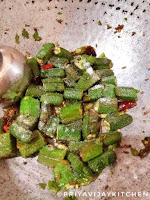
Now add in prepared coconut masala paste and water and allow it to boil for 2 to 3 minutes.

Then add 1/2 tsp of turmeric powder. Mix them well.
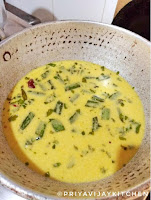
Add Salt as per your taste and allow it to boil for another 2 to 3 minutes for the raw smell of turmeric powder to go off.


[Imp note: Sauteing is must and while sauteing do not cover, covering leaves water which makes the dish sticky].
[Note: Instead of ladies finger you can use white pumpkin (poosanikai in Tamil), or cucumber. Some will use Vadam or Sundakkai vatral or even potatoes. If you are using any other veggie first precook the veggie by adding little water at this stage.]


Now add in prepared coconut masala paste and water and allow it to boil for 2 to 3 minutes.

Then add 1/2 tsp of turmeric powder. Mix them well.


Once raw smell goes off, turn off the flame, then add 1 cup of whisked curd. Mix it until curd combines well.
[Note: Add curd only after switching off the flame, otherwise curd might curdles and form lumps.]
[Note: Add curd only after switching off the flame, otherwise curd might curdles and form lumps.]
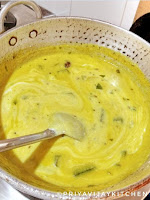
Carrot Poriyal - Carrot Stir Fry
Potato Stir Fry – Urulaikilangu Poriyal
In Tamil there is a saying “Unavae Marunthu, Marunthae Unavu” means “Food is Medicine, Medicine is Food”. In respect to the saying, each and every food we intake in our day to day life has lots of health benefits excluding junk foods and tin packed foods, of course they contain preservatives which is unhealthy.
In Indian cuisines, we use lot of ingredients in our making of recipes, which benefits us in many ways. We use them not only for their flavor and taste but for its nutritional and medicinal value as well. If we look deeper into the traditional way of cooking, all the ingredients used in each recipes are well balanced both nutritionally and medicinally.
Each ingredients have many many health benefits but without knowing their health benefits we are using them daily. Let us know at least their important health benefits before we use and eat.
Here I have listed the health benefits of each ingredients I used in the recipe.
Ingredient 1:
Ladies Finger – also known as Vendakai in Tamil, Benda Kayi in Telugu, Bendekai in Kannada, Vendakka in Malayalam, Bhindi in Hindi. Ladies finger an excellent culinary and medicinal veggie, which has lots of medicinal as well as health benefits. It is great source of fiber hence helps in digestive problems, promote weight loss, controls blood sugar levels, pregnant womens are advised to take ladies finger as they are contain folic acid and folate, rich in vitamin C helps in absorption of iron in the body.
Ingredient 2:
Curd – also known as Thayir in Tamil & Malayalam, Perugu in Telugu, Mosaru in Kannada, Dahi in Hindi. Curd, a delightful dairy product completes everyday meal in Indian cuisines. Homemade curd would be fresh and creamy which tempt us to eat a cup on one go. My mom used to prepare curd in small earthenware pot which makes curd even more tastier. Since curd is a byproduct of milk, it is also rich in calcium, vitamins and minerals. Though it is derived from milk, it is easily digestable than curd, good for digestion (because of probiotic – live bacteria), improves bone strength, immune system, very good for treating your skin (face pack for tanning) and hair (to treat dandruff), helps in weight loss by burning fat.
Ingredient 3:
Turmeric – also known as Manjal in Tamil and Malayalam, Pasupu in Telugu, Arashina in Kannada, Haldi in Hindi. In India, turmeric is consider to be most auspicious in house rituals. Turmeric medicinal value are numerous, the best antiseptic/antibiotic available in our kitchen racks. It plays a major role in Ayurveda treatment, used in skin treatment (We the south Indians use turmeric daily during our shower making our skin free from pimples, clears acne scars, makes skin flawless and glowing ), rich in antioxidants, cure cough (taking warm milk with turmeric and crushed pepper corns clears of your throat), prevents blood clots.
Ingredient 4:
Gingerly Oil – also known as Nallenai in Tamil, Nuvalu Nuna in Telugu, Nallenna in Malayalam, Ellenai in Kannada, Thil Ka Tel in Hindi. Gingerly oil have significant health benefits. South Indians widely use gingerly oil in their cooking. It is a good source of Vitamin D, E and B complex and antioxidants. Apart from it they are also used in cosmetic purposes, as they promotes healthy skin, reduces pimples and rashes by preventing bacterial infections, very good factor of gingerly oil is, it slows down aging of skin. We, the Tamilians have a tradition of taking oil bath (using gingerly oil) every Saturday by massaging the entire body and head. Massaging removes toxins from you and leaves you detoxified and bathing removes heat from the body. We religiously follow this tradition where new borns also have no exception.
Ingredient 5:
Salt – also kown as Uppu in Tamil, Telugu, Kannada & Malayalam, Namak in Hindi. There is a saying in Tamil, “Uppu Illa sapadu kuppaiyile” meaning “Food (sapadu) without salt goes to garbage (kuppai)”. That’s show how salt is an important ingredient. Salt known as sodium chloride used as a seasoning agent in almost all recipes daily. Salt helps in digestion, improves cardiovascular health, improves hydration, helps in healthy respiratory system, vital for electrolyte balance. Salt also have negativites if taken in excess, can increase blood pressure, can lead to heart disease and stroke.
Ingredient 6:
Rice – also known as Arisi in Tamil & Malayalam, Akki in Kannda, Chawal in Hindi. Rich in Carbohydrates thus acts as a fuel for the body, provides instant energy. South Indian meals are incomplete without Rice . Great source of vitamins & minerals thus improves our body metabolism, since it is low in sodium it is good for hypertension paitents, promotes healthy heart, it prevents constipation as they contain fiber as well.
Ingredient 7:
Green Chilli – also known as Pachchii Milagai in Tamil, Patchimirapa in Telugu, Hasi Menasinakai in Kannada, Pachamulagu in Malayalam, Hari Mirch in Hindi. Green chilies are more popular in Andhra Pradesh and Telangana. Though it is very hot green chilies have many good health benefits. Green chilies are rich in Vitamin C thus it boosts immune systems, rich in antioxidants, anti-inflammatory, improves digestion, helps in skin care, weight loss.
Ingredient 8:
Coconut – also known as Thengai in Tamil, Kobbari Kaaya in Telugu, Thenginakai in Kannada, Thenga in Malayalam, Nariyal in Hindi. Coconut which can be used in different forms starting from tender coconut water, coconut water, coconut oil, coconut milk and many more. Tender coconut which has lots of benefits which we can look after it separately. Fresh coconut water is sweat in taste and are tremendously beneficial to health. Coconuts are one of the main ingredients in Indian cuisines which are widely used in preparing chutneys. Cocnuts are anti-viral, anti-bacterial, boosts immune systems, rich in fiber, controls diabetics by improving insulin secretion, improves good cholesterol, has good source of vitamins (C, E, B1, B5 etc.,) and minerals (iron, calcicum etc.,) to maintain a healthy skin and healthy hair.
Ingredient 9:
Cumin Seeds – also known as Jeerakam in Tamil and Malayalam, Jeelakara in Telugu, Jeerige in Kannada, Jeera in Hindi. My Ayurveda doctor advise me to drink a glass of Jeera water on an empty stomach early in the morning which is a natural remedy for various health problems. It is a very good source of Iron thus helps to treat anaemia and boosts immunity. Drinking a glass of jeera water during menstrual cycle helps in reducing the stomach pain. During my pregnancy, doctor advised to take jeera water daily which improves digestion.
Ingredient 10:
Red Chili/ Red Chili Powder – also known as Sigappu Milagai in Tamil, Erra Mirapa Kayalu in Telugu, Vattal Mulaku in Malayalam, Molaku in Kannada, Lal Mirch in Hindi. Most widely used spices is Red chilies. They are used in recipes, for pickles, for chutneys etc., Fresh Red and Green Chilies are rich in Vitamin C, antioxidants, also good source of Vitamin A and E. If used more then you will be turn up with watery eyes and burning tongue and stomach.
Ingredient 12:
Asafoetida – also known as Perungaayam in Tamil, Inguva in Telugu, Hingu in Kannada, Kaayam in Malayalam, Hing in Hindi. Asafoetida have distinct flavor and aroma. It is a key ingredient in Indian cuisines used mostly in curries and dal. It has very high medicinal value apart from its health benefits. It is mainly used in home remedies for stomach upset & intestinal gas. Whenever we prepare dal, we use to season it with asafetida in order to balance the gaseous effort dal produce. It’s a natural cure for asthma and bronchitis, relieves menstrual pain, cures ear aches, heals insects bites.
In Indian cuisines, we use lot of ingredients in our making of recipes, which benefits us in many ways. We use them not only for their flavor and taste but for its nutritional and medicinal value as well. If we look deeper into the traditional way of cooking, all the ingredients used in each recipes are well balanced both nutritionally and medicinally.
Each ingredients have many many health benefits but without knowing their health benefits we are using them daily. Let us know at least their important health benefits before we use and eat.
Here I have listed the health benefits of each ingredients I used in the recipe.
Ingredient 1:
Ladies Finger – also known as Vendakai in Tamil, Benda Kayi in Telugu, Bendekai in Kannada, Vendakka in Malayalam, Bhindi in Hindi. Ladies finger an excellent culinary and medicinal veggie, which has lots of medicinal as well as health benefits. It is great source of fiber hence helps in digestive problems, promote weight loss, controls blood sugar levels, pregnant womens are advised to take ladies finger as they are contain folic acid and folate, rich in vitamin C helps in absorption of iron in the body.
Ingredient 2:
Curd – also known as Thayir in Tamil & Malayalam, Perugu in Telugu, Mosaru in Kannada, Dahi in Hindi. Curd, a delightful dairy product completes everyday meal in Indian cuisines. Homemade curd would be fresh and creamy which tempt us to eat a cup on one go. My mom used to prepare curd in small earthenware pot which makes curd even more tastier. Since curd is a byproduct of milk, it is also rich in calcium, vitamins and minerals. Though it is derived from milk, it is easily digestable than curd, good for digestion (because of probiotic – live bacteria), improves bone strength, immune system, very good for treating your skin (face pack for tanning) and hair (to treat dandruff), helps in weight loss by burning fat.
Ingredient 3:
Turmeric – also known as Manjal in Tamil and Malayalam, Pasupu in Telugu, Arashina in Kannada, Haldi in Hindi. In India, turmeric is consider to be most auspicious in house rituals. Turmeric medicinal value are numerous, the best antiseptic/antibiotic available in our kitchen racks. It plays a major role in Ayurveda treatment, used in skin treatment (We the south Indians use turmeric daily during our shower making our skin free from pimples, clears acne scars, makes skin flawless and glowing ), rich in antioxidants, cure cough (taking warm milk with turmeric and crushed pepper corns clears of your throat), prevents blood clots.
Ingredient 4:
Gingerly Oil – also known as Nallenai in Tamil, Nuvalu Nuna in Telugu, Nallenna in Malayalam, Ellenai in Kannada, Thil Ka Tel in Hindi. Gingerly oil have significant health benefits. South Indians widely use gingerly oil in their cooking. It is a good source of Vitamin D, E and B complex and antioxidants. Apart from it they are also used in cosmetic purposes, as they promotes healthy skin, reduces pimples and rashes by preventing bacterial infections, very good factor of gingerly oil is, it slows down aging of skin. We, the Tamilians have a tradition of taking oil bath (using gingerly oil) every Saturday by massaging the entire body and head. Massaging removes toxins from you and leaves you detoxified and bathing removes heat from the body. We religiously follow this tradition where new borns also have no exception.
Ingredient 5:
Salt – also kown as Uppu in Tamil, Telugu, Kannada & Malayalam, Namak in Hindi. There is a saying in Tamil, “Uppu Illa sapadu kuppaiyile” meaning “Food (sapadu) without salt goes to garbage (kuppai)”. That’s show how salt is an important ingredient. Salt known as sodium chloride used as a seasoning agent in almost all recipes daily. Salt helps in digestion, improves cardiovascular health, improves hydration, helps in healthy respiratory system, vital for electrolyte balance. Salt also have negativites if taken in excess, can increase blood pressure, can lead to heart disease and stroke.
Ingredient 6:
Rice – also known as Arisi in Tamil & Malayalam, Akki in Kannda, Chawal in Hindi. Rich in Carbohydrates thus acts as a fuel for the body, provides instant energy. South Indian meals are incomplete without Rice . Great source of vitamins & minerals thus improves our body metabolism, since it is low in sodium it is good for hypertension paitents, promotes healthy heart, it prevents constipation as they contain fiber as well.
Ingredient 7:
Green Chilli – also known as Pachchii Milagai in Tamil, Patchimirapa in Telugu, Hasi Menasinakai in Kannada, Pachamulagu in Malayalam, Hari Mirch in Hindi. Green chilies are more popular in Andhra Pradesh and Telangana. Though it is very hot green chilies have many good health benefits. Green chilies are rich in Vitamin C thus it boosts immune systems, rich in antioxidants, anti-inflammatory, improves digestion, helps in skin care, weight loss.
Ingredient 8:
Coconut – also known as Thengai in Tamil, Kobbari Kaaya in Telugu, Thenginakai in Kannada, Thenga in Malayalam, Nariyal in Hindi. Coconut which can be used in different forms starting from tender coconut water, coconut water, coconut oil, coconut milk and many more. Tender coconut which has lots of benefits which we can look after it separately. Fresh coconut water is sweat in taste and are tremendously beneficial to health. Coconuts are one of the main ingredients in Indian cuisines which are widely used in preparing chutneys. Cocnuts are anti-viral, anti-bacterial, boosts immune systems, rich in fiber, controls diabetics by improving insulin secretion, improves good cholesterol, has good source of vitamins (C, E, B1, B5 etc.,) and minerals (iron, calcicum etc.,) to maintain a healthy skin and healthy hair.
Ingredient 9:
Cumin Seeds – also known as Jeerakam in Tamil and Malayalam, Jeelakara in Telugu, Jeerige in Kannada, Jeera in Hindi. My Ayurveda doctor advise me to drink a glass of Jeera water on an empty stomach early in the morning which is a natural remedy for various health problems. It is a very good source of Iron thus helps to treat anaemia and boosts immunity. Drinking a glass of jeera water during menstrual cycle helps in reducing the stomach pain. During my pregnancy, doctor advised to take jeera water daily which improves digestion.
Ingredient 10:
Mustard seeds – also known as Kadugu in Tamil and Malayalam, Avalu in Telugu, Rai in Hindi. Mustard seeds are most probably used by all people all over the world in some or other form either via seeds or by oil or as sauce used in their recipes. We south Indian people use it as whole seeds. They are mostly used for seasoning the dishes. It is a high nutritious seeds rich in calcium, protein, manganese, iron, zinc, omega 3 fatty acids and dietary fiber. Mustard oil helps in Hair growth, hair loss, hydrates skin, and acts as a natural scrubber.
Ingredient 11:Red Chili/ Red Chili Powder – also known as Sigappu Milagai in Tamil, Erra Mirapa Kayalu in Telugu, Vattal Mulaku in Malayalam, Molaku in Kannada, Lal Mirch in Hindi. Most widely used spices is Red chilies. They are used in recipes, for pickles, for chutneys etc., Fresh Red and Green Chilies are rich in Vitamin C, antioxidants, also good source of Vitamin A and E. If used more then you will be turn up with watery eyes and burning tongue and stomach.
Ingredient 12:
Asafoetida – also known as Perungaayam in Tamil, Inguva in Telugu, Hingu in Kannada, Kaayam in Malayalam, Hing in Hindi. Asafoetida have distinct flavor and aroma. It is a key ingredient in Indian cuisines used mostly in curries and dal. It has very high medicinal value apart from its health benefits. It is mainly used in home remedies for stomach upset & intestinal gas. Whenever we prepare dal, we use to season it with asafetida in order to balance the gaseous effort dal produce. It’s a natural cure for asthma and bronchitis, relieves menstrual pain, cures ear aches, heals insects bites.
Ingredient 13:
Curry Leaves – also known as Kariveppilai in Tamil, Karivepaku in Telugu, Karibevu in Kannada, Kariveppila in Malayalam, Kadi Patta in Hindi. Curry leaves, I should call it as a magical leaves, because it has numerous health benefits. For children this curry leaves would be annoying leaf even for me when I am kid. We the South Indians use curry leaves daily in almost every recipes we prepare, we use it while seasoning the food. When we say its health benefits, the first thing strikes our mind is that it is good for long and strong hair, apart from that there are many more. It stops diarrhea, helps in digestion, lowers cholesterol levels and blood sugar levels, good for eyesight, rich in Vitamin C thus help to clean your blood, leaving skin fresh and healthy, rich in calcium, iron. Tip: 1. Mix curry leaves powder with buttermilk for stomach upset. 2. Having curry leaves with lemon juice clears off morning sickness in pregnant women. 



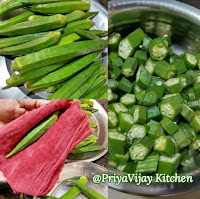
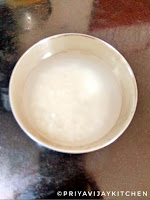

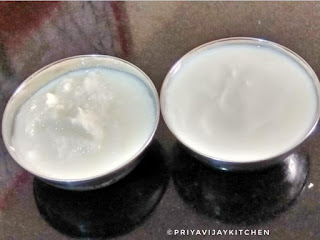




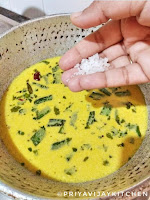


No comments:
Post a Comment